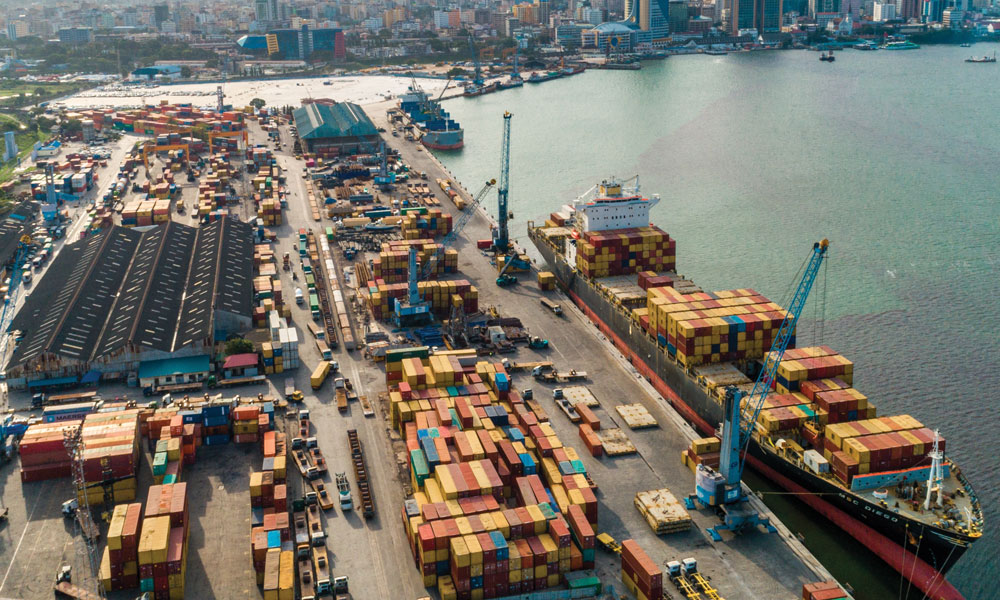TANZANIA has a complex port history tied into African trade routes and colonialism. Tanzania is the largest country in East Africa, its coastline dominating the Swahili Coast, which stretches north into Kenya and south through the northern coast of Mozambique.
Tanzania was formed in 1964, its name derived from those of the former states of Tanganyika and Zanzibar. Between 1885 and 1918, present-day Tanzania was part of a German colony, which also included Burundi and Rwanda. The coastal town of Bagamoyo, which has one of the oldest ports in Tanzania, was chosen as the capital of German East Africa before the port city of Dar es Salaam became the capital in 1891.
Dar es Salaam is now Tanzania’s largest city and commercial hub, but it is no longer the capital. Tanzania in 1974 decided it would move its capital inland to the city of Dodoma, but the city was not officially recognised as such until 1996.
TRADE OVERVIEW
Tanzania’s agricultural production grew in the 1970s and ‘80s, and the country’s industry is now based on processing of its agricultural goods. Agriculture accounts for about two fifths of the country’s gross domestic product, with corn (maize), rice, millet, bananas and casava among its major crops. The island of Zanzibar produces about a tenth of the world’s cloves, but it was once the source of about nine tenths.
Gold is Tanzania’s most valuable export, providing more than two-thirds of the country’s export earnings in the early 2000s. Other principal export commodities are coffee, cashew nuts and cotton. Its biggest imports are machinery, transport equipment, petroleum and chemical products.
Tanzania’s main exports to Australia are coffee and agricultural crops, according to the Department of Foreign Affairs and Trade. Total two-way trade between the two nations in 2022-23 was $145 million.
INDUSTRY LANDSCAPE
Dar es Salaam remains the maritime hub of Tanzania, its port handling about 95% the country’s international trade, according to the state-owned Tanzania Ports Authority. The port also serves the landlocked countries of Zambia, the Democratic Republic of the Congo, Burundi, Rwanda, Malawi, Uganda and Zimbabwe.
Elsewhere in the maritime logistics landscape are the Port of Tanga in northern Tanzania and Mtwara Port in the country’s south. There is also a cluster of small ports on Zanzibar and inland ports on the edges of Lake Victoria, Lake Tanganyika and Lake Nyasa. The Tanzania Coastal Shipping Line – TACOSHILI for short – offers transport services along the coast.
Ferry operator Azam Marine runs passenger services between Dar es Salaam, Zanzibar and the island of Pemba. The Azam fleet is Australian-built – Incat Crowther and Richardson Devine Marine delivered the newest addition Kilimanjaro VIII in April last year after sea trials in Hobart. Kilimanjaro VIII, or Falcon of the Sea, was the 11th vessel Incat Crowther designed for the operator, and the eighth built by RDM. It joins Jewel of Zanzibar, The Pearl of Stone Town and Lady of Zanzibar.
MARITIME CHALLENGES
The IMO has hosted several workshops and seminars in Tanzania over the past year, some focusing on maritime training in Tanzania and others addressing maritime challenges in wider African regions. One of those issues is ferry safety.
Just last month IMO and Interferry urged countries in Africa to develop and update their national legislation to include adequate measures to ensure domestic ferry safety. The message followed a regional seminar in Dar es Salaam, hosted by the Tanzania Shipping Agencies Corporation, which set out to address a reportedly high number of casualties throughout the wider region, linked to ferry transportation.
Participants from Cameroon, Cabo Verde, the Democratic Republic of the Congo, Ethiopia, Gabon, Ghana, Kenya, Madagascar, Morocco, Nigeria, Senegal, South Africa, Togo and Uganda also took part in discussions. They represented maritime administrations, ferry shipping company operators and finance and insurance providers.
The regional seminar focused on “common problems such as ticketing and overcrowding, loading and stowage, design and construction failure, as well as a lack of insurance and political will,” according to a recap from the IMO.
One of the biggest challenges the panellists and participants identified was a lack of resources to fund new builds, training of crew and maintenance of the ferries.
And at the conclusion of the meeting, participating countries were urged to develop, review and update their national legislative and administrative requirements and practices relating to the operation of domestic vessels and passenger ferries. The aim is to ensure adequate safety measures are included in national legislation and practices.
Other recent workshops in Tanzania have focused on maritime security, including developing the capacity of national authorities to carry out control and compliance measures on ships.
This article appeared in the May 2024 edition of DCN Magazine





